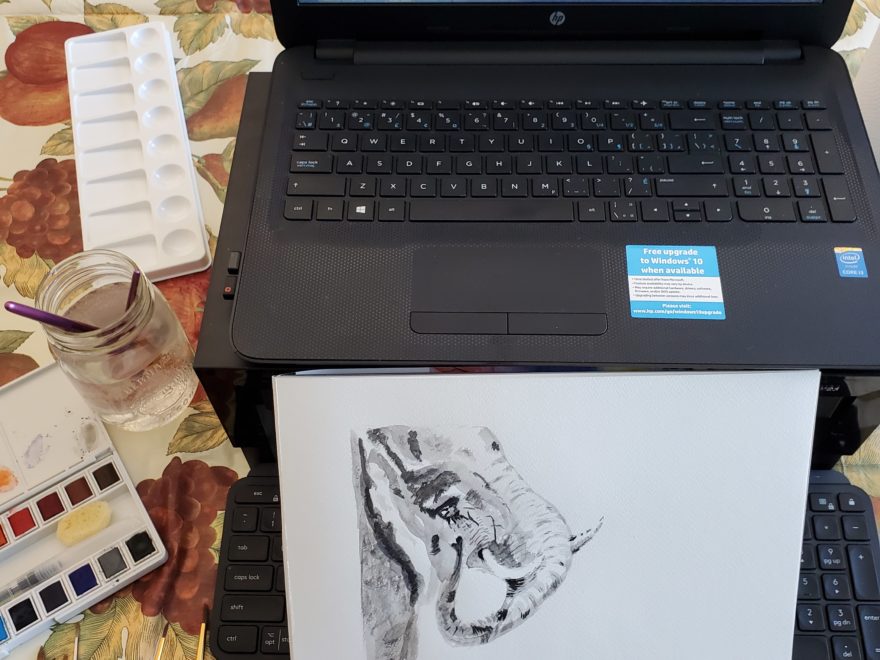At this time last year, I was looking forward to a whole series of creative courses and workshops that would have just been getting underway. I’d signed up for a variety of these, being offered either for free or at very reasonable prices through local art initiatives, community centres, and libraries during the winter months.
There was a course on creative journaling, integrating both collage and drawing, and an introduction to clay sculpture. The one that I was most anxious to start was on learning to use watercolour paints, and I’d even bought all the supplies that I could possibly need. Several pads of watercolour paper in different weights and surface types or textures, quite a few sets of brushes, and two different types of watercolour paints; in dry pans, and in tubes.
My hope had been to use this eclectic mix of artistic courses and workshops to create a kind of do-it-myself art therapy program. I’d have to adapt – or relearn – techniques, to account for the damage that a rare disease has caused to my right hand and arm. Adapting (better) to this new reality was also one of my goals. Only my thumb is fully functional on that hand; my wrist and finger joints have become somewhat unusable as I can’t bend them – or grip – much anymore
Following the adage ‘use it or lose it’, I believe that continuing to try to use this hand in different ways is important for preventing further deterioration. Research has also shown that disuse – lack of use – of their effected limb(s) is common among patients with my rare disease; Complex Regional Pain Syndrome (CRPS), formerly known as RSD or Reflex Sympathetic Dystrophy:
Secondary complications from CRPS include sequelae of disuse including contractures as well as altered sensation of the affected limb.
Infection, edema, dystonia, and myoclonus… Dystrophic changes of nails, skin, and hair, osteopenia (Sudeck’s atrophy), and small nerve fiber dropout may occur.
Impaired sympathetic vasoconstriction may also occur and lead to presyncope or syncope.” (1)
These are all, obviously, symptoms and outcomes that I’d like to avoid in affected my right hand and arm. Hence my planed DIY art therapy program for 2020. As with everyone’s plans for last year, all of the courses and workshops for which I’d registered were cancelled due to the current pandemic.
After putting my home-made art therapy program on hold for a year, I decided to begin 2021 by searching for some virtual art courses and workshops. Not DIY videos on YouTube, I wanted something more interactive – a platform offering a more personal connection during the near-lockdown and curfew situation here in Montréal.
As I already had the supplies I’d purchased for the cancelled “Learning to use watercolours” course, still in their wrappings, I focused on courses for this. After a few weeks of searching, I’d found some possible watercolour courses. Unfortunately many of these were full- or half-day courses, something that I can no longer manage. Why?
One of the many facets of CRPS, being both an autoimmune and a neuro-inflammatory disease, is that it can cause cognitive impairment in up to 65% of long-term patients. Including me; I was diagnosed with a mild cognitive impairment in late 2018, with which I continue to struggle:
Significant neuropsychological deficits are present in 65% of patients, with many patients presenting with elements of a dysexecutive syndrome and some patients presenting with global cognitive impairment.” (2)
As a result of this cognitive impairment, I can only concentrate or focus on something for about an hour at a time. After ruling out any introductory watercolour painting courses or workshops that ran longer than an hour or so, I happened to read an article in The Guardian newspaper by a journalist who had taken a ‘virtual art safari’ to the Galápagos Islands:
Lockdown has forced this unusual journey on me, but it has proved to be one I am very glad to have taken.” (3)
This concept definitely intrigued me; combining art instruction with (virtual) travel. The course-safari described by the journalist was offered by a company called Art Safari, based in Suffolk England. When I checked their website, I noticed that they were soon offering a couple of free one-hour workshops; a perfect opportunity to see whether I liked their format, before registering for a paid course:
Creative workshops for everyone wanting to learn more!
Intense, action-focused days of learning to see and paint with our experienced tutors.” (4)
The first Art Safari workshop for which I’d registered took place on January 27. I unfortunately missed the first fifteen minutes of the session, due to a phone conversation with the Director of my multidisciplinary pain clinic; the Alan Edwards Pain Management Unit (AEPMU), within the McGill University Health Centre (MUHC).
I was being invited to once again co-present to second-year medical students at McGill University, as I did with the AEPMU Director back in 2019. This time, of course, our student presentation would be a virtual event rather than in the in-person session we held two years ago. These are presentations that I adore doing, whether virtual or in person, so I quickly agreed; more on that presentation to follow in a future post – stay tuned!
After missing the first quarter of that watercolour painting workshop I was a bit lost, but tried to follow along as best I could. Let’s just say that I won’t be posting any of my paintings from that workshop, unless I take some time to go back and ‘fix’ them; they were all fairly horrid! The two artists presenting the workshop were lovely though,, sharing stories of previous Art Safari travels, and I truly enjoyed it.
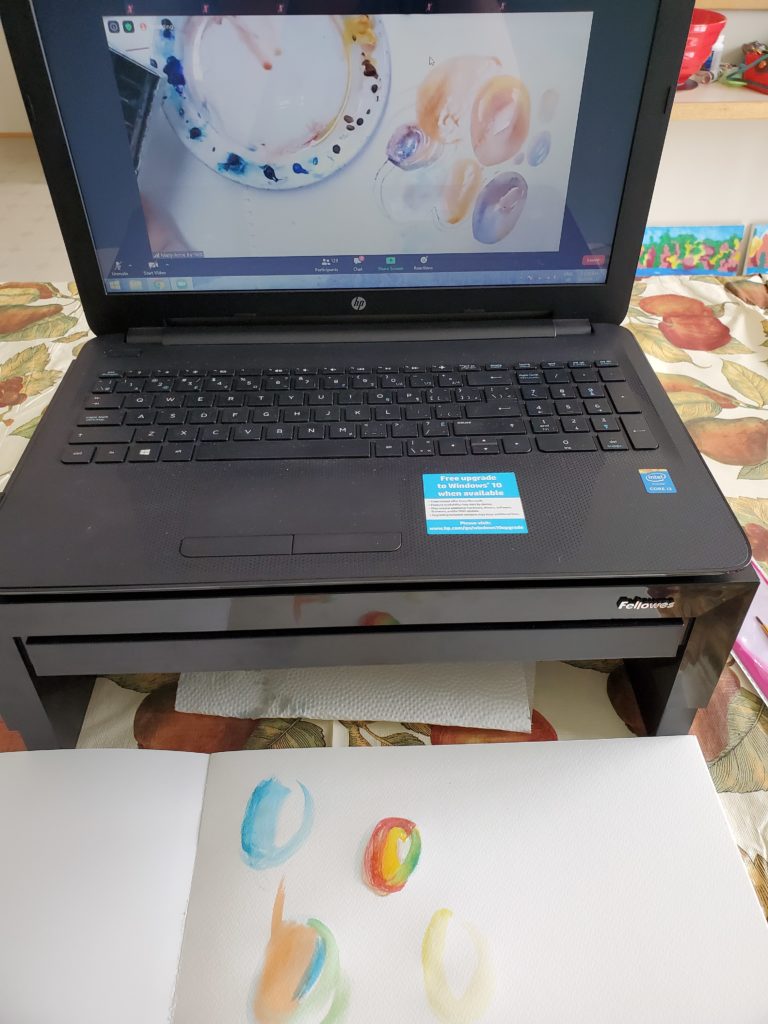
The whole session, via ZOOM, was very calming; I described it to my better half as “meditation while painting”. This, I realized, was the kind of art training that I’d been looking for. A sense of connection, of story-telling and experience-sharing, combined with instructions and painting practice exercises. They even offer a closed social media group, on which participants can share their results and comment on others’.
Although I missed the initial instructions, this workshop was a good opportunity to practise trying to hold a paint brush in unconventional ways to account for my CRPS-affected fingers and wrist. Wedging the brush between my thumb and the inner edge of my right hand provided not-too-horrible results for some less-detailed painting. Using a paint brush wedged between my index and ring fingers seemed to work slightly better for details.
Neither ‘technique’ can compare to the type of painting that I had hoped to do, in a more natural hand position. But I try, always, to focus on what I can do rather than on what I can’t. There are artists who paint beautifully with their mouths or their feet, so surely I can manage to paint passably despite a somewhat inhibited right hand. Once I learn some basic techniques, that is!
Today was the second Art Safari workshop for which I’d registered, in advance of the actual watercolour painting course that I’ll be taking the weekend after next – wish me luck! Today’s session was on drawing and painting elephants, using images from some of these artists’ past art safaris and travel to Africa and Asia, as well as live webcam images of elephants in situ.
Elephants aren’t animals that I’d ever have thought of drawing, particularly not in the middle of a cold and snowy Montreal winter, but it was an unexpected pleasure to virtually ‘travel’ to warmer climes for an hour today. Even though I draw and paint very slowly these days, finding ways to hold pencils and brushes that don’t trigger horrific neuropathic pain flares, I managed to get a decent start on a couple of elephant images during this one-hour session.
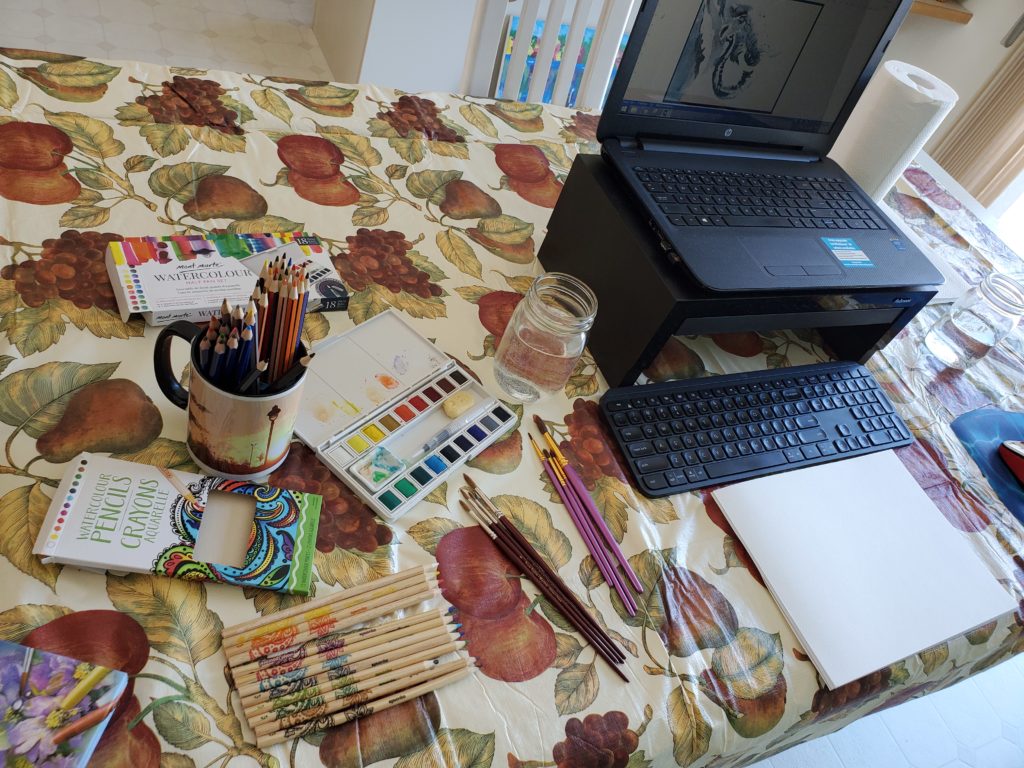
Photo ©Sandra Woods; Virtual art tutorial by Art Safari Ltd (artsafari.co.uk) 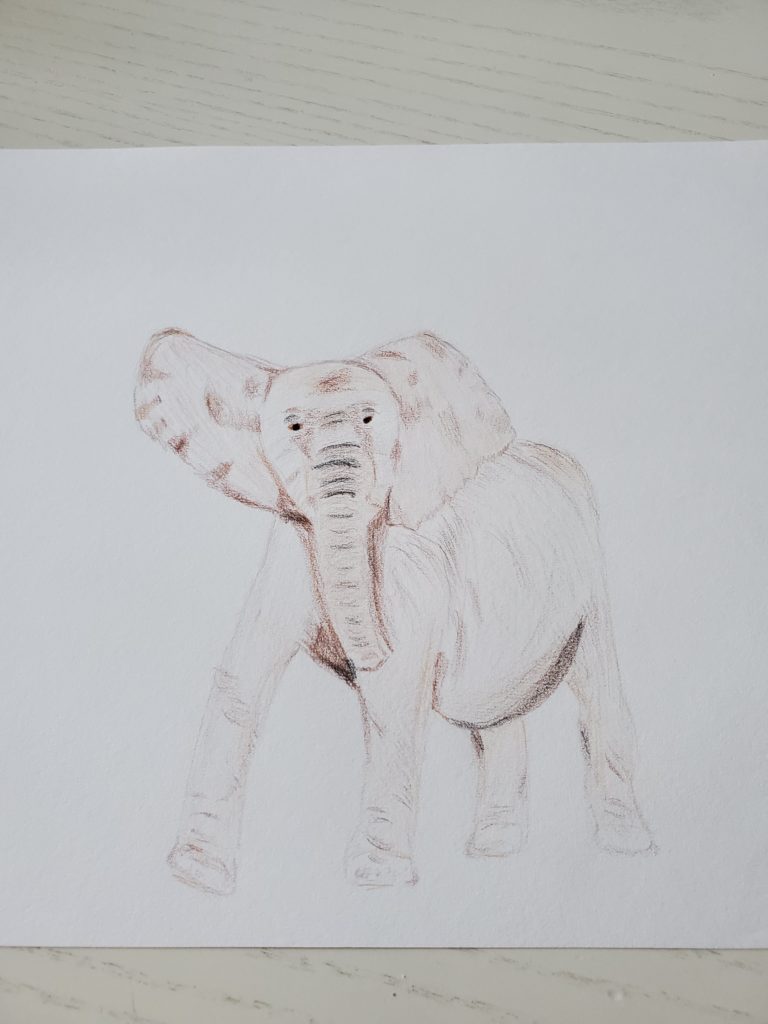
Photo & drawing ©Sandra Woods
This watercolour painting of an elephant was one that I’d started in advance of the session, based on one of the images emailed along with the access code to the ZOOM workshop. I have to say that I’m quite pleased with it, as it’s my first-ever watercolour… bearing in mind that I haven’t yet taken a watercolour painting course!
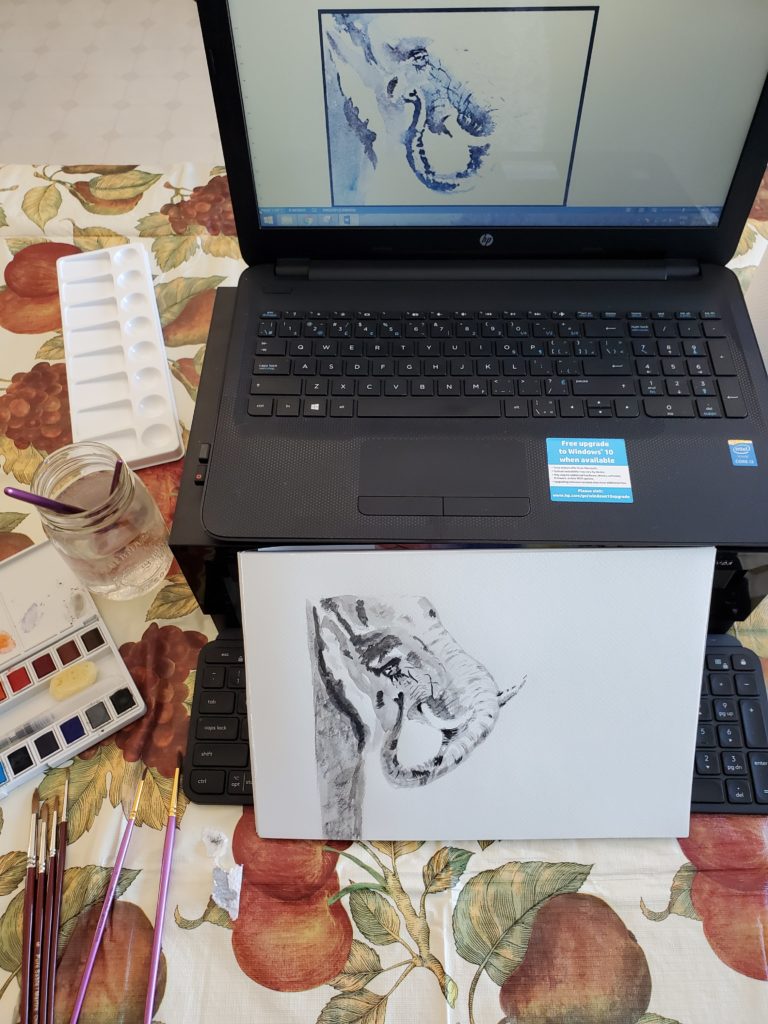
The chickadee is a type of bird that we see every day at our backyard bird feeders. In local forests, these tiny birds will land on the open palm of your hand, to pick up peanuts. You can barely feel their weight, only the tickling sensation of their feet on your skin. I’d long told myself that this would be the first type of bird that I’d try to paint, so I did this one a few hours after today’s workshop.
I used a combination of watercolour pencils and paints, to see how these pencils work when water is added to drawings. Did I mention that I’d purchased quite a lot of watercolour art supplies, in advance of the course for which I’d registered in 2020?! This set of watercolour pencils was still in its plastic wrap, the package unopened for well over a year – until I decided to draw-paint the chickadee today.
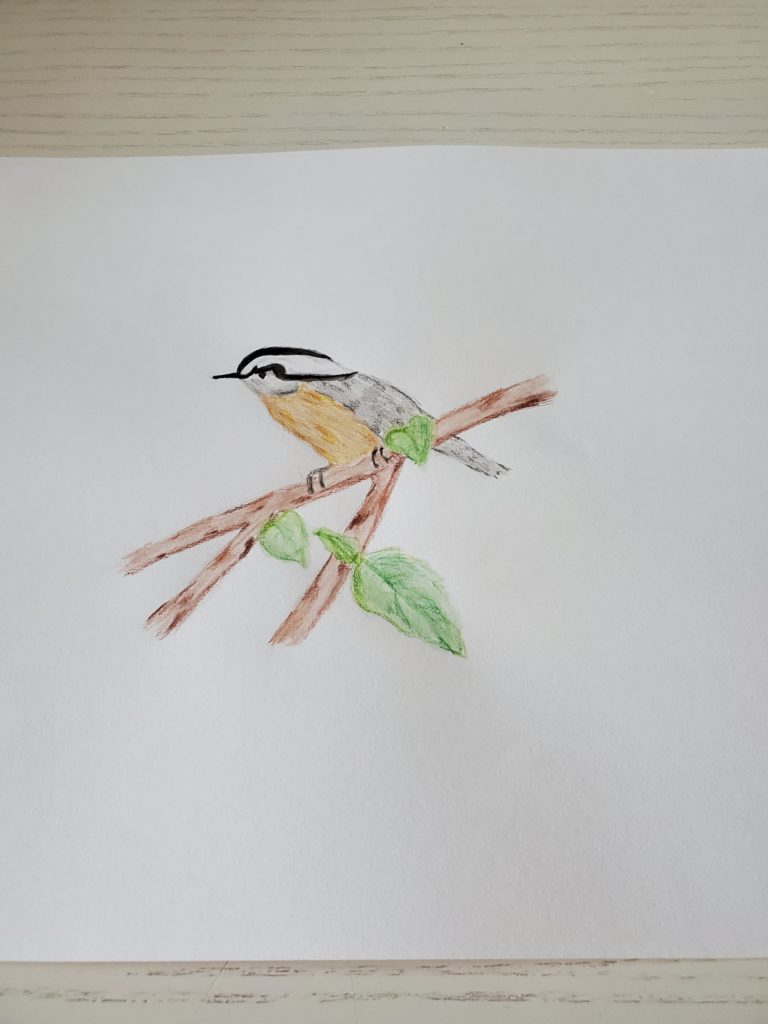
Again, I’m fairly happy with this ‘first-ever’ painting. You’ve probably noticed that there are no backgrounds in anything that I drew or painted today… that’s one of the skills I’m hoping to learn something about during the upcoming watercolour painting course.
Today I tried something completely new, and had a lot of fun while virtually visiting other countries and finding new ways to use my CRPS-affected hand. My DIY art therapy program, it seems, is already working!
As always, I wish you happiness and joy – and health that’s as good as it can be. These days, I also share my hopes for safety and for feelings of well-being. This remains a difficult time, around the world and across the country, so events like these art workshops can provide a welcome break.
Feel free to reach out over on Instagram or Twitter; managing the comments here was too much for me to handle with my cognitive impairment, so I’ve had to disable that feature here on the blog. I still love to hear from you, though!
References
(1) Laurentiu Dinescu, Justin Faye, Alec Guerzon, and Michael Mosier. Complex Regional Pain Syndrome Part 1: Essentials of Assessment and Diagnosis. PM&R KnowledgeNow. American Academy of Physical Medicine and Rehabilitation (AAPRMR). 09 Aug 2012; Updated 07 Jan 2021. Accessed 03 Feb 2021. Online:
https://now.aapmr.org/complex-regional-pain-syndrome-part-1-essentials-of-assessment-and-diagnosis/
(2) Libon, David J, Schwartzman, Robert J, Eppig, Joel, et al. Neuropsychological deficits associated with Complex Regional Pain Syndrome. J International Neuropsychological Society (JINS). 2010; 16, 566–573. 19 Mar 2010. doi:10.1017/S1355617710000214. Accessed 03 Feb 2021:
https://www.cambridge.org/core/journals/journal-of-the-international-neuropsychological-society/article/neuropsychological-deficits-associated-with-complex-regional-pain-syndrome/F56D83F23BB269C52DDF43198BA0536D#
(3) Kevin Rushby. I’m painting the amazing Galápagos wildlife – from my sitting room. The Guardian (newspaper). Guardian News & Media Limited. 24 Jan 2021. Accessed 03 Feb 2021. Online:
https://www.theguardian.com/travel/2021/jan/24/painting-amazing-galapagos-islands-wildlife-virtual-class
(4) Art Safari Ltd. UK Workshops. Webpage. Woodbridge, Suffolk. Accessed 03 Feb 2021. Online:
https://artsafari.co.uk/uk-sketching-workshops-and-virtual-workshops/

